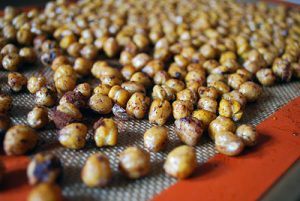
The name chickpea comes from the Latin word cicer, referring to the plant family of legumes, Fabaceae. It is also known by its popular Spanish-derived name, the garbanzo bean. Kidney beans, black beans, lima beans, and peanuts are other familiar foods found in this legume family. These plants produce edible seeds, called pulses, that have high nutritional value. Two main varieties of chickpeas are the larger round light-colored Kabuli-type, common in the United States, and the smaller dark irregularly shaped Desi-type often used in India and the Middle East.
Chickpeas appear in early recordings in Turkey about 3500 BCE and in France 6790 BCE. India produces the most chickpeas worldwide but they are grown in more than 50 countries. An excellent source of carbohydrate, protein, fiber, B vitamins, and some minerals, they are a nutritious staple of many diets.
Source Of
- Protein
- Folate
- Fiber (both insoluble and soluble)
- Iron
- Phosphorus
- Polyunsaturated and monounsaturated fatty acids including linoleic and oleic acids
Chickpeas and Health
Chickpeas and all pulses contain several components that, when eaten as part of a balanced plant-rich diet, may help prevent the development of various chronic diseases [1-7]
- Diabetes: Both dried and canned chickpeas have a low glycemic index and low glycemic load, and contain amylose, a resistant starch that digests slowly. These factors help to prevent sudden surges in blood sugar and insulin levels, which can improve overall blood sugar control in people with type 2 diabetes. [1-3,5-7]
- Gut Flora: Chickpeas contain a soluble fiber called raffinose, a type of oligosaccharide that is fermented in the colon by beneficial bacteria called Bifidobacterium. As bacteria break down this fiber, a short chain fatty acid called butyrate is produced. Butyrate plays a role in reducing inflammation in the cell wall of the colon, promoting regularity in the intestines, and possibly preventing colorectal cancer by promoting cell apoptosis (death). [1,3,4]
- Heart Disease: Chickpeas contain a plant sterol called sitosterol that is structurally similar to cholesterol in the body. It interferes with the body’s absorption of cholesterol and thereby can help to lower blood cholesterol levels. The fiber and unsaturated fats in chickpeas may also favorably affect blood lipid levels. [1-3,5-7]
- Obesity: High fiber foods can help to promote a feeling of fullness and satiety by delaying digestion and adding bulk to meals. The satiating effect of the high fiber and protein content of chickpeas may help with weight management. [1-3,5,7]
Make

Chickpeas are widely available dried or canned. Occasionally you may find young, fresh green chickpeas in their pods at farmers’ markets.
- Dried: Sort through the beans to check for and remove small stones or debris, then place in a strainer and rinse well. To speed up the cooking time, dry beans may be presoaked by covering with water and allowing to sit for at least 3 hours, or overnight. Some people who feel bloated after eating beans may find that presoaked beans are better tolerated, as this reduces the amount of oligosaccharides that are responsible for the uncomfortable side effects.
- Cook: For 1 cup of dry garbanzo beans, add 3 cups of water or broth. Add to pan and bring to a boil. When boiling, reduce the heat to low-medium and simmer for 60-90 minutes or until desired tenderness. Add more water if the beans do not reach desired tenderness and further cook time is needed. Using presoaked beans will reduce the cook time by 25%.
- Canned: Place in a strainer, drain, and rinse well. This will remove about 40% of the sodium, or you can purchase low sodium or no-salt-added canned versions. These do not need additional cooking but hold up well when added to cooked or baked dishes.
Serve
Chickpeas have a nutty buttery flavor and creamy texture that can enhance many recipes. There are various ways to incorporate cooked chickpeas:
- Add to salads, soups, and stews.
- Use a food processor or blender to grind into a paste and add to veggie burgers or meatless meatballs.
- Season and roast for a tasty snack.
- Blend with tahini, garlic, olive oil, and lemon juice to make a hummus spread.
- Mash and use in baking as a replacement for flour.
More recipe ideas and serving suggestions featuring chickpeas:
Did You Know?
- Roasted and ground chickpeas have been used as a caffeine-free alternative to coffee for centuries. The beverage is also available as ready-to-brew commercial brands in some grocery stores.
- Don’t throw out chickpea liquid, either from canned beans or from cooking the bean! It is called aquafaba, a thick liquid containing a mix of starch and trace amounts of protein, with emulsifying, binding, and thickening properties. It works well as a flavorless, odorless egg replacer in recipes: 1 tablespoon of aquafaba = 1 egg yolk, 2 tablespoons = 1 egg white, and 3 tablespoons = 1 one whole egg. It can also be whipped to replace the eggs in meringues or mayonnaise.
- Unlike many canned vegetables, canned chickpeas retain much of their nutritional value and are comparable to dried cooked versions.
Terms of Use
The contents of this website are for educational purposes and are not intended to offer personal medical advice. You should seek the advice of your physician or other qualified health provider with any questions you may have regarding a medical condition. Never disregard professional medical advice or delay in seeking it because of something you have read on this website. The Nutrition Source does not recommend or endorse any products.


